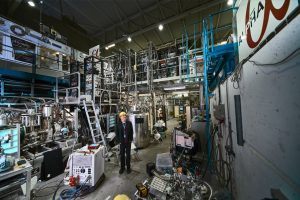Ana Lopes at the website of CERN:
 In a paper published today in the journal Nature, the ALPHA collaboration reports that it has literally taken antimatter to a new level. The researchers have observed the Lyman-alpha electronic transition in the antihydrogen atom, the antimatter counterpart of hydrogen, for the first time. The finding comes hot on the heels of recent measurements by the collaboration of another electronic transition, and demonstrates that ALPHA is quickly and steadily paving the way for precision experiments that could uncover as yet unseen differences between the behaviour of matter and antimatter.
In a paper published today in the journal Nature, the ALPHA collaboration reports that it has literally taken antimatter to a new level. The researchers have observed the Lyman-alpha electronic transition in the antihydrogen atom, the antimatter counterpart of hydrogen, for the first time. The finding comes hot on the heels of recent measurements by the collaboration of another electronic transition, and demonstrates that ALPHA is quickly and steadily paving the way for precision experiments that could uncover as yet unseen differences between the behaviour of matter and antimatter.
The Lyman-alpha (or 1S-2P) transition is one of several in the Lyman series of electronic transitions that were discovered in atomic hydrogen just over a century ago by physicist Theodore Lyman. The transition occurs when an electron jumps from the lowest-energy (1S) level to a higher-energy (2P) level and then falls back to the 1S level by emitting a photon at a wavelength of 121.6 nanometres.
It is a special transition. In astronomy, it allows researchers to probe the state of the medium that lies between galaxies and test models of the cosmos. In antimatter studies, it could enable precision measurements of how antihydrogen responds to light and gravity. Finding any slight difference between the behaviour of antimatter and matter would rock the foundations of the Standard Model of particle physics and perhaps cast light on why the universe is made up almost entirely of matter, even though equal amounts of antimatter should have been produced in the Big Bang.
More here.
